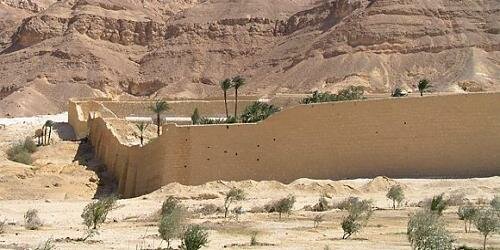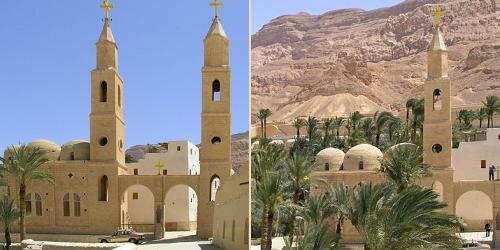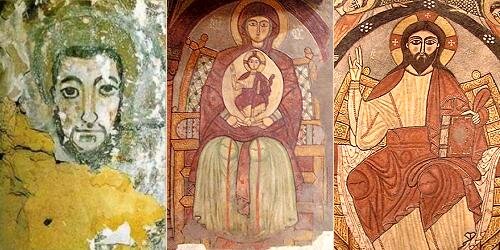|
|
||||||||||||||
|
|
The fortress-like Coptic monastery of St Anthony the Great stands at an oasis spring in the Red Sea Mountains, 155 km (100 miles) south east of Cairo. It was founded in the mid-4th century, on Saint Anthony's burial site. He, along with St Pachomius (the first monk to organise hermits into groups) were two of the first exponents of Christian monasticism, which originated in the Egyptian desert. The Coptic orthodox monastery, presided over by an abbot, is the oldest Christian monastery in the world. The church is one of Egypt's great treasures - some of the wall paintings here date from the 6th and the 9th centuries, and among them is a picture of the founder, St Anthony himself. He lived in a tiny cave, high above the desert, for 40 years soon after AD 300, and the monastery - really a city in the desert - was built in the 360s. Amazingly, the monks who live here still speak Coptic, a language directly descended from the language of the ancient Egyptians. St Anthony the person
Anthony then headed out into the rugged desert terrain of Wadi el-Natrun to live as a hermit. His isolated lifestyle was remarkably harsher than his predecessors, and it is said that he was tormented throughout his life by the flatteries and temptations of the devil. These he initially overcame by the power of prayer, but not without consequence, and when locals from a nearby village discovered him unconscious, they took his body back to the church to recover. After a brief respite, Anthony felt compelled to return to his anchoritic lifestyle, and this time he settled in an abandoned Roman fort in the Fayyum. Still suffering from the torments of the devil, Anthony remained there for twenty years, only communicating with the outside world through a crevice by means of which he would say a few words and sometimes give advice, and from where food could be passed through to him. Then one day he emerged from the fort. With the help of the villagers, they had broken down the door, expecting him to have wasted away, or perhaps gone insane in his solitary confinement. To their amazement, he emerged healthy, serene, and enlightened. He had experienced great personal ordeals, yet had emerged from his internment spiritually rejuvenated. He was hailed as a hero and from this time forth the legend of Anthony began to spread and grow. Anthony visited Alexandria, offering comfort to the Christians imprisoned there for their beliefs. Openly confessing his faith, he was ordered to leave the city by the Governor of Alexandria. Anthony refused, publicly arguing with him in the distracted hope that he himself would be imprisoned and subsequently martyred. This did not happen, so Anthony returned to the abandoned fort in the desert that had been his home for so long. His reputation growing, many people came to visit him at the fort. Ultimately realising that the increasing visits were keeping him from his worship, Anthony decided to move deeper into the desert, roaming the wilderness for three days before finally settling by a spring of water and some palm trees. It is at this very spot that the monastery of St Anthony's now stands.
Deir Mar Antonios, Christianity's oldest monastery St Anthony's monastery lies at the foot of the el-Qalzam mountain near el-Zafarana, and was founded in 356 AD just after Anthony's death. It is the oldest active monastery in the world. Hidden deep in the Red Sea mountains and relying on springs for their water supply, the Coptic monks at the monastery today still observe rituals that are little changed in 16 centuries. Although knowledge of its early history is scant, we know that during the 6th and 7th centuries many monks from the Wadi Natrun area who suffered frequent attacks by nomadic Bedouin tribes sought sanctuary at St Anthony's. But St Anthony's itself was also subject to raids and attacks on many occasions, and during the 11th century was partly destroyed. These attacks prompted strong defences and fortifications, and between the 12th and 15th centuries the monastery flourished. In 1454 however, Bedouin servants plundered St Anthony's, and used many of the monastery's ancient handwritten manuscripts as cooking fuel. Today, around 1700 manuscripts survive in the monastery's library. Today, Deir Mar Antonios is a fortified self-contained village with gardens, a mill, a bakery, a library and five churches.
St Anthony's has exceptional wall paintings of holy knights in bright colours and the hermit founders of the monastery in subdued colours and icons. These wall paintings, widely known to monks and art historians, were originally obscured by layers of soot, candle grease, oil and dust. Recently, in a collaborated effort between the Supreme Council of Antiquities and the American Research Centre in Egypt, these unique and beautiful paintings were restored. One set of the paintings is attributed to a team lead by a Coptic master named Theodore, whilst the other set appears to have been executed by team with a Byzantine influence. The oldest paintings date back to the 7th and 8th century, whilst the more recent examples are from the 13th century. In addition to the restoration work undertaken on the wall paintings, the woodwork inside St Anthony's Church was also restored.
Saint Anthony, together with Saint Paul the Hermit are seen as the founders of Christian monasticism. Although Anthony himself did not organise or create a monastery as such, a community did grow up around him based upon his example of living an ascetic and isolated life. Those who wished to follow him needed the company of others in order to survive the harsh desert conditions. The nearby monastery of Saint Paul the Hermit exists to this day, and both monasteries are accessible by special tours from Cairo, Suez or Hurghada. A stay in either monastery can also be arranged in advance. Return to Coptic monasteries >>
|
|||||||||||||

|
||||||||||||||
|
||||||||||||||





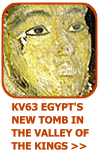


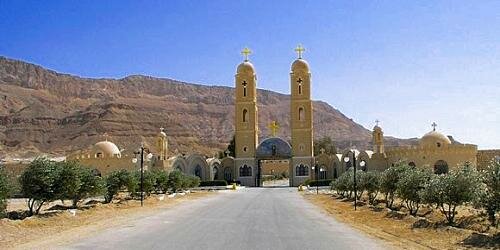
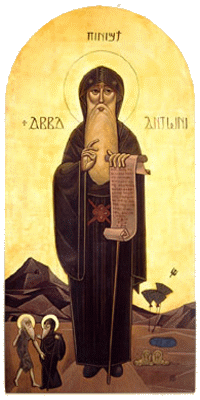 Anthony was born near Heraclea in Upper Egypt in the year 251 AD to wealthy parents. When he was twenty years old, his parents died and left him with the care of his unmarried sister. In 285, he decided to follow the path of Christianity and the teachings of Jesus, and so gave his wealth to the poor and needy, and placed his sister in the care of a group of Christian virgins, a sort of proto-nunnery at the time.
Anthony was born near Heraclea in Upper Egypt in the year 251 AD to wealthy parents. When he was twenty years old, his parents died and left him with the care of his unmarried sister. In 285, he decided to follow the path of Christianity and the teachings of Jesus, and so gave his wealth to the poor and needy, and placed his sister in the care of a group of Christian virgins, a sort of proto-nunnery at the time.